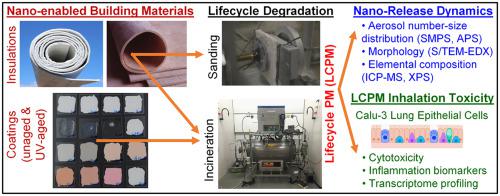Journal of Hazardous Materials ( IF 13.6 ) Pub Date : 2021-07-29 , DOI: 10.1016/j.jhazmat.2021.126771 Dilpreet Singh 1 , Antonella Marrocco 1 , Wendel Wohlleben 2 , Hae-Ryung Park 3 , Avantika R Diwadkar 4 , Blanca E Himes 4 , Quan Lu 5 , David C Christiani 1 , Philip Demokritou 1

|
The present study investigates potential nanomaterial releases and occupational health risks across the lifecycle of nano-enabled building materials (NEBMs), namely, insulations and coatings. We utilized real-world degradation scenarios of a) sanding (mechanical), b) incineration (thermal), and c) accelerated UV-aging (environmental) followed by incineration. Extensive physicochemical characterization of the released lifecycle particulate matter (LCPM) was performed. The LCPM2.5 aerosol size fraction was used to assess the acute biological, cytotoxic and inflammatory effects on Calu-3 human lung epithelial cells. RNA-Seq analysis of exposed cells was performed to assess potential for systemic disease. Findings indicated that release dynamics and characteristics of LCPM depended on both the NEBM composition and the degradation scenario(s). Incineration emitted a much higher nanoparticle number concentration than sanding (nearly 4 orders of magnitude), which did not change with prior UV-aging. Released nanofillers during sanding were largely part of the matrix fragments, whereas those during incineration were likely physicochemically transformed. The LCPM from incineration showed higher bioactivity and inflammogenicity compared to sanding or sequential UV-aging and incineration, and more so when metallic nanofillers were present (such as Fe2O3). Overall, the study highlights the need for considering real-world exposure and toxicological data across the NEBM lifecycle to perform adequate risk assessments and to ensure workplace health and safety.
中文翻译:

纳米建筑材料 (NEBM) 在其整个生命周期中释放的颗粒物:潜在的职业健康和安全影响
本研究调查了纳米建筑材料 (NEBM)(即绝缘材料和涂料)整个生命周期中潜在的纳米材料释放和职业健康风险。我们利用了真实世界的降解场景 a) 打磨(机械),b) 焚烧(热),和 c) 加速紫外线老化(环境)然后焚烧。对释放的生命周期颗粒物 (LCPM) 进行了广泛的物理化学表征。LCPM 2.5气溶胶大小分数用于评估对 Calu-3 人肺上皮细胞的急性生物学、细胞毒性和炎症作用。对暴露的细胞进行 RNA-Seq 分析以评估全身性疾病的可能性。研究结果表明,LCPM 的释放动力学和特征取决于 NEBM 成分和降解情景。焚烧排放的纳米颗粒数量浓度比砂磨(近 4 个数量级)高得多,这不会随着先前的紫外线老化而改变。在打磨过程中释放的纳米填料主要是基质碎片的一部分,而在焚烧过程中释放的纳米填料可能发生物理化学变化。与砂磨或顺序紫外线老化和焚烧相比,焚烧产生的 LCPM 显示出更高的生物活性和致炎性,2 O 3)。总体而言,该研究强调需要考虑整个 NEBM 生命周期中的真实世界暴露和毒理学数据,以执行充分的风险评估并确保工作场所的健康和安全。



























 京公网安备 11010802027423号
京公网安备 11010802027423号